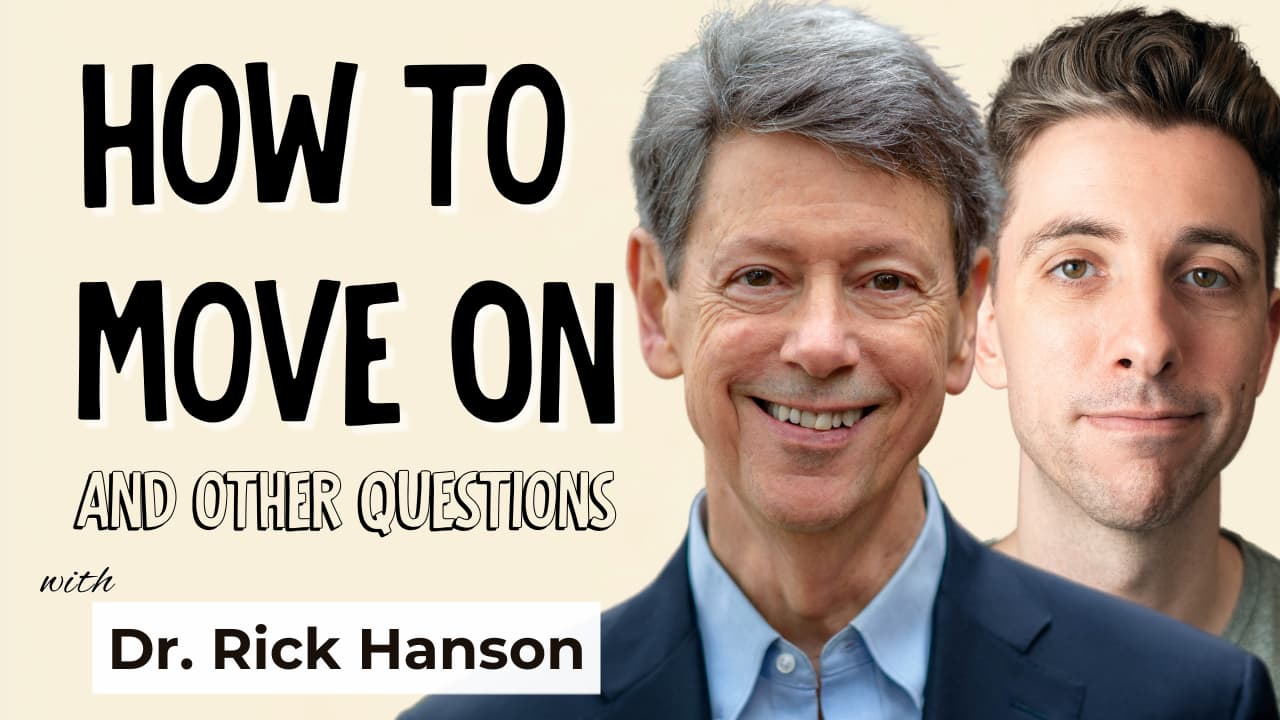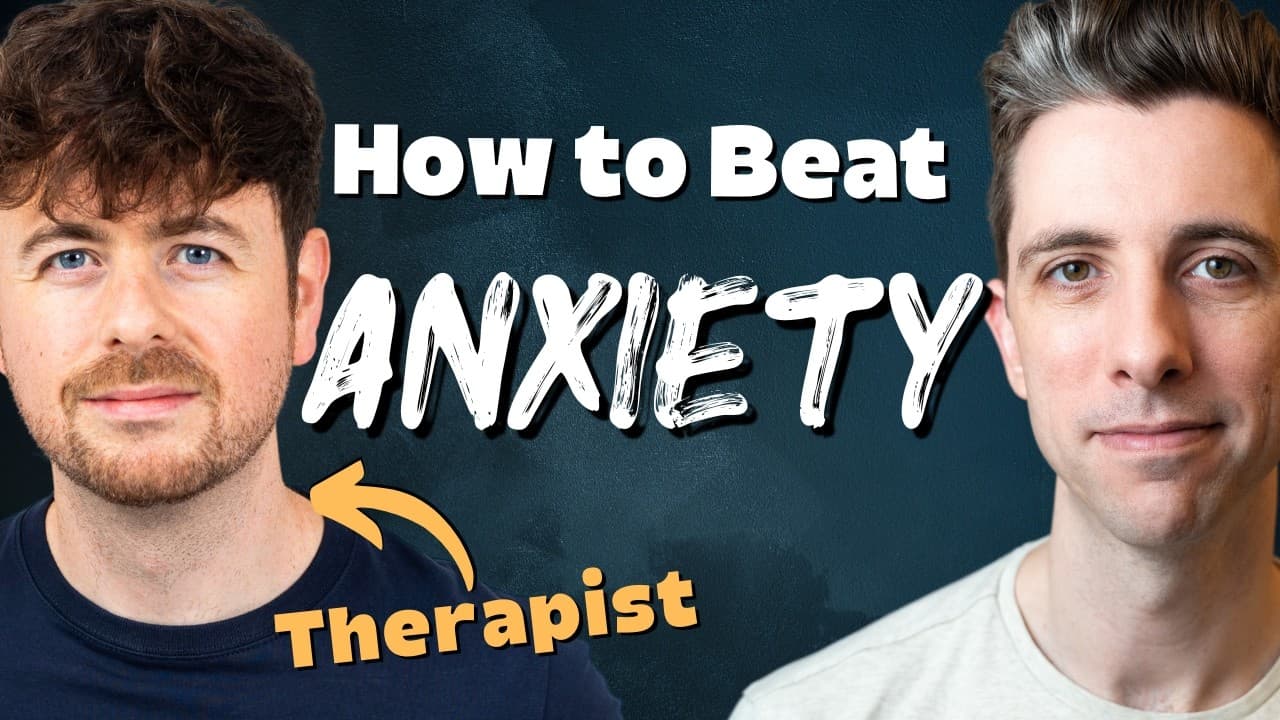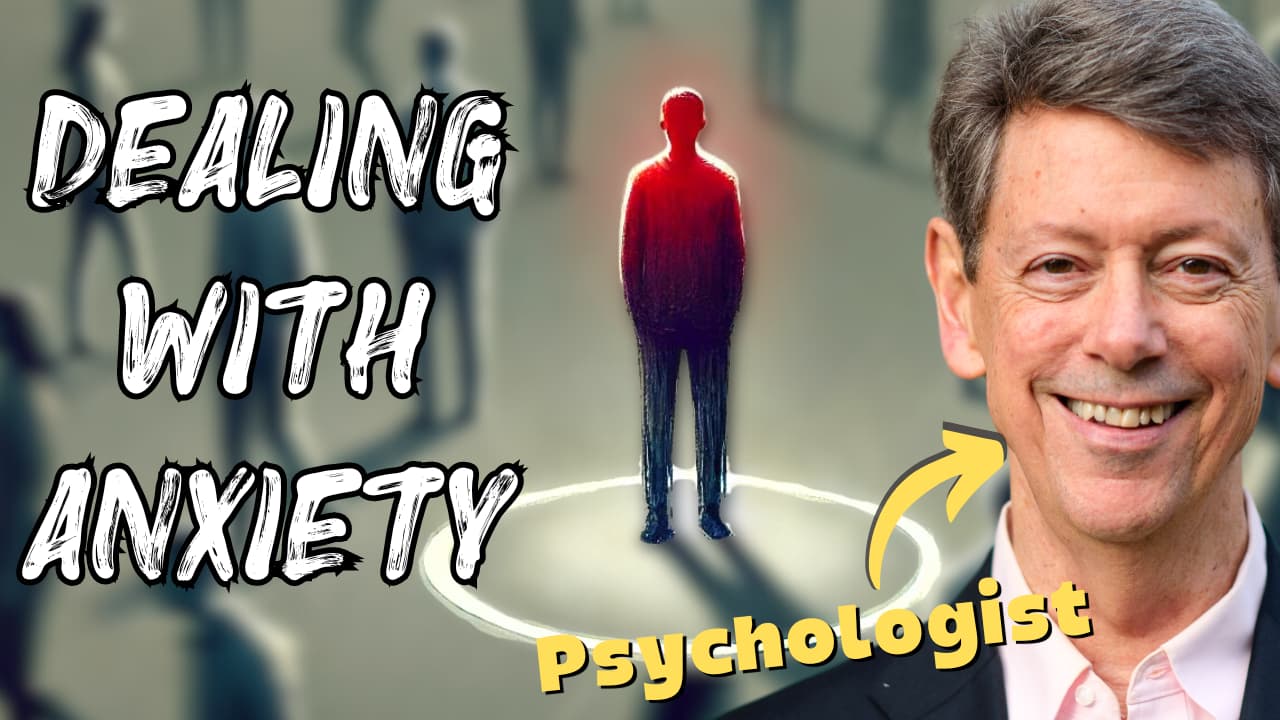10 Somatic Exercises and Techniques for Anxiety: Expert-Approved
Home > Resources for Anxiety > Somatic Exercises for Anxiety
Anxiety impacts both the mind and body, often causing tension, rapid breathing, and restlessness. Somatic exercises provide a well-researched approach to calming the nervous system, promoting relaxation, and restoring balance by addressing the physical aspects of anxiety. This article is informed by insights from leading experts such as Dr. Rick Hanson, a psychologist and expert in positive neuroplasticity, and Dr. Peter Levine, the developer of Somatic Experiencing. Drawing on their expertise, we’ll explore practical exercises and tools to reduce anxiety and enhance resilience.
Dealing with Anxiety
ONLINE COURSE
Anxiety, fear, and worry are normal reactions, but they don’t have to be your constant companions. Let go of anxiety and grow a greater sense of calm, strength, and being protected and supported by other people with these 5 powerful practices.
Benefits and Role of Somatic Exercises for Anxiety
Somatic exercises offer a body-centered approach to alleviating anxiety, helping to release tension, enhance emotional regulation, and build a lasting sense of calm and resilience.
- Immediate Relief:
- Activates the parasympathetic nervous system, calming the “fight or flight” response.
- Reduces physical tension, such as tight muscles or a racing heart.
- Provides grounding techniques to bring focus back to the present moment.
- Improved Emotional Regulation:
- Encourages awareness of bodily sensations linked to anxiety, promoting self-regulation.
- Helps recognize early signs of anxiety and intervene effectively before symptoms escalate.
- Builds resilience over time by completing unresolved stress cycles.
- Enhanced Mind-Body Connection:
- Reconnects the physical and emotional aspects of anxiety for a holistic approach.
- Creates a sense of safety and grounding, essential for managing overwhelming emotions.
- Encourages mindful practices that improve focus and reduce anxious thoughts.
- Long-Term Well-Being:
- Supports healthier stress responses by releasing stored tension.
- Encourages regular relaxation, leading to better mental and physical health.
- Complements other therapeutic approaches to create a well-rounded anxiety management plan.
Somatic Exercises and Techniques for Anxiety: Expert Approved
These techniques are informed by expert insights, including those of Dr. Peter Levine, the creator of Somatic Experiencing, and Dr. Rick Hanson, a psychologist and neuroscientist renowned for his work on resilience and well-being.
calensThese expert-approved methods are designed to help you reconnect with your body, manage stress responses, and find relief from anxiety in accessible and effective ways.
1. Pendulation
Pendulation, a term introduced by Peter Levine (2010), refers to the process of moving back and forth between two states: the trauma vortex and the healing vortex. It mirrors the natural rhythm of the nervous system as it transitions between states of activation (stress) and deactivation (relaxation). This process is designed to make navigating difficult sensations more manageable while maintaining an anchor in safety. Pendulation is a foundational method in somatic approaches, particularly for addressing physical manifestations of anxiety.
Purpose:
Pendulation aims to help individuals regulate their nervous systems by fostering a balance between discomfort and calm. By intentionally moving between states of tension and ease, this technique encourages the body to release anxiety-related sensations in a gradual, controlled way. It also allows you to build trust in your ability to handle uncomfortable emotions, promoting resilience over time. For people with anxiety, pendulation serves as a method to stay grounded and present while processing difficult physical and emotional sensations safely.
How to Practice:
- Identify a challenging sensation: Bring your attention to an area in your body where you feel tension, such as tightness in your chest, heaviness in your shoulders, or a fluttering sensation in your stomach.
- Focus on a calming area: Redirect your focus to a part of your body that feels neutral or pleasant, such as the stability of your feet on the ground or the warmth of your hands resting on your lap.
- Alternate focus: Slowly move your attention between the area of discomfort and the area of calm, spending about 10–15 seconds on each. Pay attention to any changes in sensations as you switch.
- End on comfort: Conclude the exercise by resting your attention on the neutral or calming area, allowing your body to relax into a state of ease.
2. Titration
Titration involves breaking down intense or overwhelming sensations into smaller, more manageable pieces. Rather than addressing all anxiety-related feelings at once, this technique encourages you to work with small, tolerable amounts of physical or emotional sensations. This gradual approach ensures that you remain in control, preventing emotional flooding or increased anxiety. Titration aligns with the principle of addressing anxiety incrementally to reduce its overall intensity.
Purpose:
The purpose of titration is to help you process and release stored tension in a way that feels safe and controlled. By focusing on manageable sensations, you can explore and work through anxiety without becoming overwhelmed. This method is particularly beneficial for those who experience heightened physical responses to stress, as it allows for slow and steady desensitization. Over time, titration fosters a sense of self-efficacy and strengthens your ability to navigate moments of heightened anxiety with greater confidence.
How to Practice:
- Find a mild sensation: Pay attention to a subtle sensation in your body that feels slightly uncomfortable, such as a faint tightness in your chest or a small knot in your stomach.
- Observe without judgment: Allow yourself to notice this sensation for a few seconds without trying to change it. Be curious and observe its qualities, such as intensity, size, or movement.
- Shift focus to a neutral area: Redirect your attention to a part of your body that feels stable or calm, such as your feet resting on the ground or your hands on your knees.
- Return briefly to the original sensation: Bring your focus back to the mild discomfort and observe it again briefly before shifting to the neutral area.
- Repeat in small increments: Alternate between the two areas several times, limiting your exposure to the discomfort and returning to the neutral area as needed.
3. Resourcing
Resourcing is the practice of connecting with positive memories, sensations, or external objects that bring a sense of safety and calm. This technique draws on the body’s natural ability to anchor itself in feelings of comfort and stability, even during moments of heightened anxiety. Resourcing can involve imagining a safe place, recalling a supportive memory, or noticing neutral sensations in the body.
Purpose:
The purpose of resourcing is to create a reliable foundation of safety that you can return to when experiencing anxiety. This technique strengthens the nervous system’s ability to regulate itself by focusing on comfort and ease. For individuals with anxiety, resourcing provides a mental and physical “safe haven,” reducing the impact of stressful sensations and allowing for greater resilience. By building this connection to safety, you train your body and mind to recover more quickly from states of distress.
How to Practice:
- Choose a resource: Think of a positive memory, such as spending time with loved ones or being in nature, or focus on a physical sensation that feels neutral or pleasant (e.g., the warmth of your hands).
- Engage your senses: Recall the colors, sounds, or textures associated with the resource. Notice how this affects your body.
- Stay present with the resource: Spend a few moments focusing on the feelings of comfort and safety the resource provides.
- Reconnect as needed: When anxiety arises, return to your resource to stabilize and ground yourself.
4. Grounding and Body Awareness
Grounding and body awareness involve focusing on the sensations in your body and the connection between your body and the physical environment. This technique helps anchor you in the present moment, reducing the “floating” or disconnected feeling that often accompanies anxiety.
Purpose:
Grounding helps to interrupt the spiral of anxious thoughts by bringing your attention to tangible, physical sensations. This connection to the present moment allows you to feel more stable and in control. For individuals with anxiety, grounding creates a sense of embodiment, helping to counteract feelings of detachment or overwhelm.
How to Practice:
- Feel your connection to the ground: Notice the weight of your body on the chair or the sensation of your feet touching the floor.
- Engage your senses: Pay attention to the texture of the surface beneath you, the temperature of the air, or the sounds in your environment.
- Scan your body: Gently shift your focus from head to toe, noticing sensations such as pressure, warmth, or movement.
- Stay present: If your mind wanders, bring it back to the physical sensations of the moment.
5. Completing Stress Responses
Completing stress responses involves allowing your body to perform the physical actions it could not complete during moments of stress or fear. This technique mimics natural movements, such as shaking, stretching, or gentle swaying, to release stored tension and energy.
Purpose:
The purpose of completing stress responses is to restore balance in the body by resolving incomplete actions. During anxiety, the body may suppress natural responses like fight or flight. This suppression can lead to lingering tension or unease. By consciously engaging in small physical movements, you give the nervous system permission to “finish” its response, promoting relaxation and calm.
How to Practice:
- Identify stuck energy: Notice areas of tightness or agitation in your body, such as clenched fists or a stiff neck.
- Introduce gentle movement: Shake your hands, tap your feet, or sway your torso to mimic the body’s natural release of tension.
- Breathe deeply: Coordinate the movement with slow, deep breaths to enhance relaxation.
- Pause and notice: After completing the movements, observe how your body feels and whether the tension has shifted.
6. Self-Hug Exercise
The self-hug exercise involves wrapping your arms around yourself to create a sense of containment and comfort. This simple physical gesture mimics the soothing effect of being held and provides an immediate sense of safety and calm.
Purpose:
This exercise is designed to reduce feelings of anxiety by activating the body’s natural calming mechanisms. The gentle pressure of the hug signals to your nervous system that you are safe, helping to regulate your breathing and heartbeat. For those experiencing anxiety, the self-hug is a quick and accessible way to self-soothe.
How to Practice:
- Wrap your arms around yourself: Cross your arms over your chest and place your hands on your shoulders or upper arms.
- Squeeze gently: Apply light pressure, focusing on the warmth and weight of your hands.
- Breathe slowly: Inhale deeply through your nose and exhale slowly through your mouth while holding the hug.
- Release gradually: Lower your arms and take a moment to notice how your body feels.
7. Gentle Breathing Exercises
Gentle breathing exercises involve focusing on slow, deep breaths to calm the body’s stress response. By engaging the parasympathetic nervous system, these exercises counteract the physical effects of anxiety, such as rapid heartbeat or shallow breathing.
Purpose:
Controlled breathing helps lower the intensity of physical symptoms associated with anxiety, such as tightness in the chest or dizziness. By slowing your breath, you send signals to your body that it is safe to relax. This practice also increases oxygen flow to the brain, improving clarity and focus during anxious moments.
How to Practice:
- Find a comfortable position: Sit or lie down in a quiet space where you won’t be interrupted.
- Focus on your breath: Place one hand on your stomach and the other on your chest. Inhale deeply through your nose for four counts, feeling your stomach rise.
- Hold and exhale: Pause for four counts, then exhale slowly through your mouth for six counts.
- Repeat: Continue for 3–5 minutes, gradually increasing the duration if it feels comfortable.
How Somatic Exercises Can Help With Anxiety?
Anxiety doesn’t just live in your mind—it affects your body too. You might feel tight muscles, a racing heart, shallow breathing, or a sense of restlessness. Somatic exercises are body-based techniques designed to help calm these physical symptoms of anxiety. They work by focusing on how your body reacts to stress and teaching it to relax and let go. Here’s how these exercises help:
1. Calm Your Nervous System
When you’re anxious, your body’s nervous system goes into “fight or flight” mode, as if it’s preparing to face a threat. This can make your heart race, your breathing shallow, and your muscles tense. Somatic exercises help calm this system by activating your “rest and digest” mode (also known as the parasympathetic nervous system). This mode slows down your heartbeat, relaxes your muscles, and deepens your breathing, helping your entire body feel more relaxed.
Example: Try slow, controlled breathing—inhale for four counts, hold for four counts, and exhale for six counts. This type of breathwork engages the parasympathetic nervous system to calm the body.
2. Release Tension Stored in Your Body
When you feel anxious for a long time, your body holds onto that stress. This can make your shoulders tight, your back stiff, or your chest feel heavy. Somatic exercises help you notice where you’re holding tension and gently release it. Moving or stretching specific parts of your body can create a feeling of relief and ease, restoring your physical comfort.
Example: Gently shake your hands or tap your feet to release physical tension. This helps your body let go of stress in a safe, controlled way.
3. Stay in the Present Moment
Anxiety often pulls your mind into the future, making you worry about things that haven’t happened yet. Somatic exercises help you focus on the here and now by paying attention to how your body feels. Noticing sensations like the pressure of your feet on the ground or the temperature of the air can bring your mind back to the present. This focus helps quiet racing thoughts and gives you a sense of calm.
Example: Press your feet firmly into the ground and notice the sensation of support beneath you. This physical anchor keeps your mind connected to the present moment.
4. Recognize Early Signs of Anxiety
Your body often knows you’re anxious before your mind does. It might give you clues like a tight chest, fluttery stomach, or sweaty palms. Somatic exercises teach you to pay attention to these signals so you can act early, before anxiety builds up. When you catch these signs, you can use calming techniques to ease them before they escalate.
Example: Pay attention to subtle changes, like your breath quickening or your hands trembling. Recognizing these signs early helps you intervene with calming techniques, such as controlled breathing or grounding exercises.
5. Complete Your Body’s Stress Responses
When you’re anxious, your body prepares to fight, run away, or freeze. Sometimes, these actions get interrupted—like when you’re stuck in traffic or dealing with a stressful meeting—and your body doesn’t get to release the energy it built up. Somatic exercises help “finish” those stress responses in a safe and controlled way, which can restore a sense of balance and calm.
Example: Shake your hands gently or sway your body for 10 seconds to help your body release pent-up stress in a natural way.
6. Reconnect with Safety
Anxiety can make you feel like the world is unsafe, even when you’re in no danger. Somatic exercises help your body feel grounded and secure again. Simple techniques like wrapping your arms around yourself for a “self-hug” remind your body that you’re safe. This creates a sense of comfort and calm, helping to reduce feelings of fear or unease.
Example: Gently hug yourself and rock side to side to bring a soothing feeling of safety.
When to Seek Professional Guidance
While somatic exercises can be self-practiced, professional guidance is essential when the techniques feel overwhelming or trigger intense emotions. Somatic therapists provide safe, structured support to navigate these practices effectively. Look for certified practitioners, such as those trained in Somatic Experiencing, to ensure expert care tailored to your needs.
FAQ | Somatic Exercises for Anxiety
1. Are somatic exercises suitable for everyone?
Somatic exercises are generally safe for most individuals. However, if you have a history of trauma or severe anxiety, it’s advisable to consult a professional to ensure the exercises are tailored to your needs.
2. How are somatic exercises different from other anxiety treatments?
Unlike traditional talk therapies, somatic exercises focus on physical sensations and bodily awareness to address anxiety. This body-centered approach complements other methods like cognitive or mindfulness-based therapies.
3. Can somatic exercises prevent anxiety from escalating?
Yes, by teaching you to recognize early signs of anxiety, somatic exercises enable you to respond before symptoms intensify, promoting better self-regulation and calm.
4. Are these exercises evidence-based?
Yes, somatic techniques are supported by research and widely used in therapeutic practices. Experts like Dr. Peter Levine and Dr. Rick Hanson advocate their effectiveness for anxiety and stress management.
5. Can somatic exercises replace traditional therapy?
While they can be a helpful self-care tool, somatic exercises are most effective when integrated into a broader anxiety management plan, which may include therapy or other treatments as needed.
Conclusion
Somatic exercises are a gentle approach that may support managing anxiety by focusing on the connection between the mind and body. These techniques can help individuals explore ways to release tension, build resilience, and foster a sense of calm over time. Whether practiced independently or with professional guidance, they offer tools to deepen self-awareness and work towards improved emotional balance.
References
- Brown, L., & Gomez, R. (2021). Somatic movement therapy in managing anxiety disorders: A meta-analytic approach. PMC. Retrieved from https://pmc.ncbi.nlm.nih.gov/articles/PMC8276649/
- Levine, P. (2006). The emotional distress of anxiety can lead to insomnia, restlessness, and muscle aches. PMC. Retrieved from https://pmc.ncbi.nlm.nih.gov/articles/PMC181205/#:~:text=The%20emotional%20distress%20of%20anxiety,insomnia%2C%20restlessness%2C%20and%20muscle%20aches
- Lumley, M. A., & Norman, S. (2007). Even for subjects without an anxiety diagnosis, stressful tasks can cause exaggerated respiratory increases. PMC. Retrieved from https://pmc.ncbi.nlm.nih.gov/articles/PMC1820771/#:~:text=Even%20for%20subjects%20without%20an,exaggerated%20respiratory%20increases%20(48)
- Meyer, A., & Hayes-Skelton, S. A. (2023). Muscle tension in generalized anxiety disorder during a stressful mental arithmetic task: Direct original research. ResearchGate. Retrieved from https://www.researchgate.net/publication/372414229_Muscle_Tension_in_Generalized_Anxiety_Disorder_During_a_Stressful_Mental_Arithmetic_Task_Direct_Original_Research
- National Institute of Mental Health. (n.d.). Anxiety disorders. Retrieved from https://www.nimh.nih.gov/health/topics/anxiety-disorders
- Ross, S. (n.d.). Resourcing, pendulation, titration practices in somatic experiencing. Sarah Ross, Ph.D. Retrieved from https://sarahrossphd.com/resourcing-pendulation-titration-practices-somatic-experiencing/
- Sensorimotor Art Therapy Center. (n.d.). Stabilization, pendulation, and titration. Sensorimotor Art Therapy Center. Retrieved from https://www.sensorimotorarttherapy.com/blog/stabilization-pendulation-and-titration#:~:text=The%20term%20Pendulation%20was%20coined,the%20recall%20of%20stressful%20events
8. Smith, J. P., & Davidson, K. (2023). Exploring somatic techniques for anxiety relief. PMC. Retrieved from https://pmc.ncbi.nlm.nih.gov/articles/PMC10476069/

Stephanie Veillon is a creative director and instructional designer with over 15 years of experience supporting clients in the mindfulness, personal growth, well-being, learning, and psychology fields. She leverages technology, design, marketing, and best online practices to tell client stories and enhance student experience.
Know Someone Who is Struggling with Anxiety?
Use the buttons below to share this article via social media or email.
Online Course
Dealing with Anxiety
5 Powerful Practices for Less Stress
Anxiety, fear, and worry are normal reactions, but they don’t have to be your constant companions. Let go of anxiety and grow a greater sense of calm, strength, and being protected and supported by others with these 5 powerful practices.
Articles for Coping with Anxiety
Get Rick Hanson’s Free Weekly Newsletter
Get a simple practice you can do each week and the latest Being Well Podcast episode delivered right to your inbox.
Being Well Podcast: Relationship Mailbag: Finding Yourself, Boundaries, and Attachment
Nov 4, 2024
Dr. Rick and Forrest answer listener questions focused on navigating relationship challenges, including distinguishing between healthy/unhealthy desires and finding yourself after a breakup.
Being Well Podcast: The Anxiety Toolkit: How to Tolerate Uncertainty with Joshua Fletcher
Oct 21, 2024
Psychotherapist Joshua Fletcher joins Forrest for an in-depth exploration of anxiety and how to tolerate uncertainty.
Being Well Podcast: Understanding and Overcoming Social Anxiety: Attachment, Exposure, and Confidence
Oct 7, 2024
Whether you experience feelings of social
anxiety or are trying to understand a friend who does, this episode will help you feel more confident and connected.




